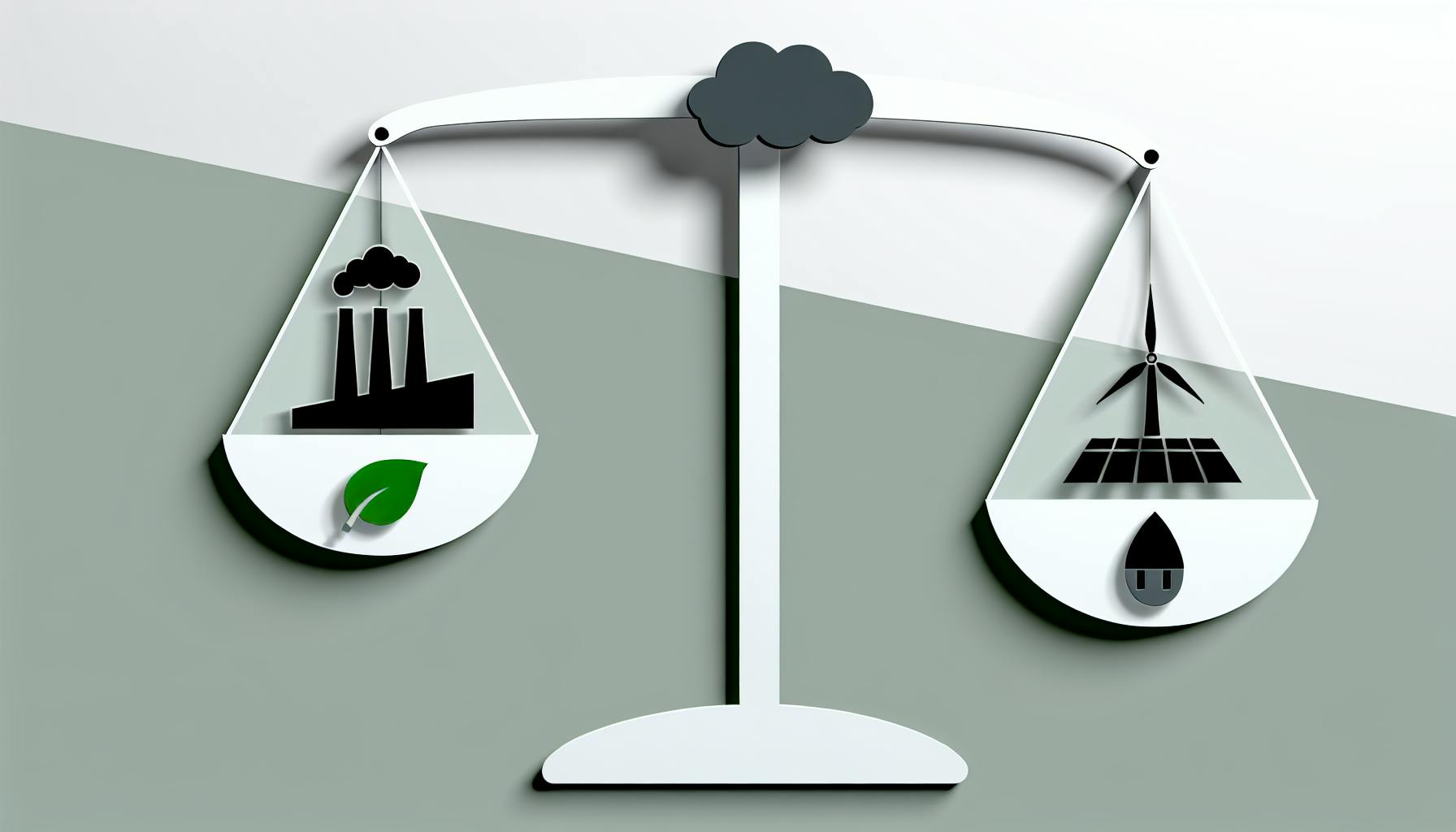A carbon footprint measures the total greenhouse gas emissions from human activities across the entire lifecycle of a product, service, or organisation. Benchmarking carbon footprints promotes transparency, accountability, and progress towards reducing emissions and mitigating climate change impacts.
Organisations can use benchmarking to:
- Identify areas for improvement
- Learn best practices
- Share knowledge
- Collaborate on emission reduction strategies
The key carbon-emitting industries and their reduction strategies are:
| Industry | Total Emissions | Reduction Strategies |
|---|---|---|
| Energy | Major source, e.g., Vistra Energy emitted 112 MtCO₂e in 2021 | Shift to renewables, improve efficiency, carbon capture |
| Manufacturing | Accounts for 1/5 of global emissions, energy-intensive | Reduce fuel use, sustainable practices, data-driven solutions |
| Transportation | 29% of U.S. emissions in 2021, mostly from road vehicles | Electrify vehicles, improve fuel efficiency, alternative modes |
| Agriculture | 19% of global emissions, from land use, livestock, fertilisers | Sustainable farming, livestock management, forest preservation |
| Services | Over 1/3 of U.S. industrial emissions, from energy use and transportation | Sustainable transportation, energy efficiency, e-waste reduction |
While benchmarking offers clarity, reduction opportunities, positive image, compliance, and cost savings, challenges include data quality issues, complexity, cost, comparison difficulties, and limited scope.
Related video from YouTube
1. Energy Sector
Total Emissions
The energy sector is a major source of greenhouse gas emissions. In the United States, Vistra Energy, a Texas-based company, was the largest corporate emitter in 2021, releasing over 112 million metric tons of carbon dioxide equivalent (MtCO₂e). This accounted for around 1.8% of total U.S. greenhouse gas emissions that year.
Emissions Intensity
The energy sector has a higher emissions intensity compared to other industries due to its reliance on fossil fuels, which are a significant source of greenhouse gas emissions. To reduce emissions intensity, the sector can:
- Transition to cleaner energy sources like renewable energy
- Improve energy efficiency
Reduction Strategies
To cut greenhouse gas emissions, the energy sector can implement strategies such as:
- Shifting to renewable energy sources like wind and solar power
- Using smart grids and advanced technologies to boost energy efficiency
- Implementing carbon capture and storage technologies
- Promoting sustainable land-use practices to reduce deforestation and encourage reforestation
Future Outlook
The energy sector plays a crucial role in reducing greenhouse gas emissions and mitigating climate change. As the sector transitions to cleaner energy sources and improves efficiency, it's essential to monitor and benchmark its carbon footprint to track progress towards emission reduction targets. By working together, the energy sector can drive meaningful change and support a low-carbon economy.
2. Manufacturing Sector
Total Emissions
The manufacturing sector is a major source of greenhouse gas emissions. The industrial sector, which includes manufacturing, accounts for one-fifth of global greenhouse gas emissions. According to the World Economic Forum, the manufacturing sector consumes around half of the world's energy resources. The largest share of industrial CO2 emissions comes from a few energy-intensive industries with high-temperature processes, such as:
- Chemicals
- Petroleum refining
- Cement
- Iron and steel
- Glass
- Pulp & paper
- Food processing
- Aluminum
Emissions Intensity
The manufacturing sector has a high emissions intensity due to its reliance on fossil fuels and energy-intensive processes. To reduce emissions intensity, the sector can:
- Transition to cleaner energy sources
- Improve energy efficiency
- Adopt sustainable practices
Embodied carbon, which is the amount of CO2e emitted during the production of a product, significantly contributes to the sector's emissions intensity.
Reduction Strategies
To cut greenhouse gas emissions, the manufacturing sector can implement the following strategies:
| Strategy | Description |
|---|---|
| Reduce fuel use | Improve efficiency and switch to less carbon-intensive fuels |
| Adopt sustainable practices | Use recycled materials and reduce waste |
| Implement data-driven solutions | Optimise production and reduce embodied carbon |
| Set internal carbon pricing | Incentivise sustainability improvements |
| Conduct life cycle assessments | Identify areas for improvement |
Future Outlook
The manufacturing sector plays a crucial role in reducing greenhouse gas emissions and mitigating climate change. By adopting sustainable practices, improving energy efficiency, and reducing emissions intensity, the sector can drive meaningful change and support a low-carbon economy. As the sector continues to evolve, it's essential to monitor and benchmark its carbon footprint to track progress towards emission reduction targets.
3. Transportation Sector
Total Emissions
The transportation sector is a major source of greenhouse gas emissions, responsible for around 29% of total U.S. emissions in 2021. Most of these emissions come from road vehicles, with light-duty trucks and passenger cars accounting for nearly 60% of the sector's total emissions.
Emissions Intensity
The transportation sector has a high emissions intensity due to its heavy reliance on fossil fuels. However, there are opportunities to reduce this intensity by:
- Transitioning to cleaner energy sources
- Improving energy efficiency
- Adopting sustainable practices
Reduction Strategies
To cut greenhouse gas emissions, the transportation sector can implement the following strategies:
| Strategy | Description |
|---|---|
| Electrify vehicles | Promote the adoption of electric vehicles and public transportation |
| Improve fuel efficiency | Develop more fuel-efficient vehicles and encourage eco-friendly driving habits |
| Alternative transport modes | Encourage walking, cycling, carpooling, and other alternative modes |
| Low-carbon fuels | Increase the use of biofuels, hydrogen, and other low-carbon fuels |
Future Outlook
The transportation sector plays a crucial role in reducing greenhouse gas emissions and mitigating climate change impacts. By:
- Adopting sustainable practices
- Improving energy efficiency
- Reducing emissions intensity
The sector can drive meaningful change and support a low-carbon economy. As the sector evolves, it's essential to monitor and benchmark its carbon footprint to track progress towards emission reduction targets.
sbb-itb-919600f
4. Agriculture Sector
Total Emissions
The agriculture sector is a major source of greenhouse gas emissions, responsible for around 19% of global emissions. In the United States, agriculture accounted for an estimated 10.6% of total greenhouse gas emissions in 2021. The main sources of emissions in this sector are:
- Land use changes, such as deforestation for farming
- Livestock production, which releases methane
- Use of fertilisers, which release nitrous oxide
Emissions Intensity
The agriculture sector has a high emissions intensity due to its reliance on:
- Land use practices
- Livestock farming
- Fertiliser application
However, there are opportunities to reduce this intensity by adopting sustainable farming methods.
Reduction Strategies
To cut greenhouse gas emissions, the agriculture sector can implement the following strategies:
| Strategy | Description |
|---|---|
| Sustainable Farming | Use conservation tillage, cover crops, and efficient fertiliser application to reduce emissions |
| Livestock Management | Improve breeding and feeding practices to reduce methane from livestock |
| Forest Preservation | Preserve and restore forests to maintain their carbon absorption capacity |
| Climate-Smart Agriculture | Implement farming practices that reduce emissions and improve crop yields |
Future Outlook
The agriculture sector plays a crucial role in reducing greenhouse gas emissions and mitigating climate change impacts. By:
- Adopting sustainable practices
- Improving efficiency
- Reducing emissions intensity
The sector can drive positive change and support a low-carbon economy. As the sector evolves, it's essential to monitor and benchmark its carbon footprint to track progress towards emission reduction targets.
5. Service Sector
Total Emissions
The service sector, including industries like banking, healthcare, technology, and retail, is responsible for over one-third of industrial greenhouse gas emissions in the US. Research shows that the sector's emissions significantly contribute to the country's overall carbon footprint.
Emissions Intensity
The service sector's emissions intensity is influenced by factors like:
- Energy consumption: Activities like data processing and storage are energy-intensive.
- Transportation: Employee commuting and business travel contribute to emissions.
- Electronic devices: The production and use of computers, phones, and other devices add to the sector's carbon footprint.
Reduction Strategies
To reduce emissions, service sector companies can implement strategies such as:
| Strategy | Description |
|---|---|
| Sustainable Transportation | Encourage public transport, carpooling, or remote work to reduce commuting emissions. |
| Energy Efficiency | Switch to energy-efficient lighting, equipment, and optimise energy use in buildings and data centers. |
| Electronic Waste Reduction | Implement recycling programs for electronic devices and promote energy-efficient models. |
| Sustainable Practices | Encourage employees to reduce paper usage, use eco-friendly products, and adopt sustainable behaviors. |
The Pros and Cons of Measuring Carbon Footprints
Measuring an organisation's carbon footprint can be a valuable tool, but it also has its drawbacks. Here, we'll look at the advantages and disadvantages of carbon footprint benchmarking to help you make an informed decision.
Advantages
| Benefit | Description |
|---|---|
| Clarity | Benchmarking provides a clear picture of your organisation's greenhouse gas emissions, helping you identify areas for improvement. |
| Reduction Opportunities | By comparing your footprint to industry averages or best practices, you can find ways to cut emissions and costs. |
| Positive Image | Organisations that prioritise reducing their carbon footprint are often seen as environmentally responsible, enhancing their reputation. |
| Regulatory Compliance | Benchmarking can help organisations meet existing and future carbon regulations. |
| Cost Savings | Reducing energy consumption and emissions can lead to significant cost savings. |
Disadvantages
While measuring carbon footprints offers benefits, there are also potential drawbacks:
| Drawback | Description |
|---|---|
| Data Quality Issues | Inaccurate or incomplete data can lead to incorrect benchmarking results, making it essential to ensure data quality. |
| Complexity | Carbon footprint benchmarking can be a complex process, requiring significant resources and expertise. |
| Cost | Benchmarking can be a costly process, especially for smaller organisations. |
| Comparison Challenges | Comparing carbon footprints between organisations can be challenging due to differences in operations, locations, and industries. |
| Limited Scope | Benchmarking may not account for all emissions sources, such as scope 3 emissions, which can be a significant portion of an organisation's overall carbon footprint. |
Key Takeaways
Comparing carbon footprints is important: Organisations need to understand how their emissions compare to others in their industry. This helps them set realistic goals, find areas to improve, and share results with stakeholders.
Data quality and consistency are challenges: It can be difficult to collect and compare emissions data due to differences in how organisations calculate their carbon footprints.
Industry benchmarks exist: Many sectors, like utilities, materials, and energy, have benchmarks for emissions intensity. Organisations can use these to assess their performance and identify opportunities.
Benefits of reducing emissions: By cutting energy use and emissions, organisations can save money and build a reputation as an environmentally-friendly business.
Limitations to consider: Benchmarking carbon footprints can be complex, costly, and may not account for all emission sources like supply chain emissions (scope 3).
Comparing Carbon Footprints
| Benefit | Description |
|---|---|
| Clarity | See a clear picture of your emissions to find areas to improve. |
| Identify Reductions | Compare to industry averages or best practices to cut emissions and costs. |
| Positive Image | Organisations that prioritise reducing emissions are seen as environmentally responsible. |
| Compliance | Benchmarking helps meet existing and future carbon regulations. |
| Cost Savings | Reducing energy use and emissions can lead to significant cost savings. |
| Challenge | Description |
|---|---|
| Data Issues | Inaccurate or incomplete data can lead to incorrect benchmarking results. |
| Complexity | Benchmarking can be a complex process requiring resources and expertise. |
| Cost | Benchmarking can be costly, especially for smaller organisations. |
| Comparisons | Differences in operations, locations, and industries make comparisons difficult. |
| Limited Scope | Benchmarking may not account for all emission sources like supply chain emissions. |
FAQs
What are the 5 most carbon-emitting industries?
The 5 industries that produce the most carbon emissions are:
1. Materials
- Includes chemicals, construction materials, packaging, metals, and mining
2. Energy
- Covers oil and gas exploration/production and energy equipment
3. Industrials
- Encompasses capital goods, commercial services, and transportation
4. Consumer Staples
- Includes food, household goods, and personal products
5. Utilities
- Covers electricity, gas, and water supply
These industries significantly contribute to greenhouse gas emissions due to their operations and processes.
Which industry emits the most carbon?
The fossil fuels industry has the highest carbon footprint, emitting 40.5 gigatons of CO2 in 2022, a 1% increase from the previous year. This sector is a major contributor to global emissions due to the nature of its activities.



